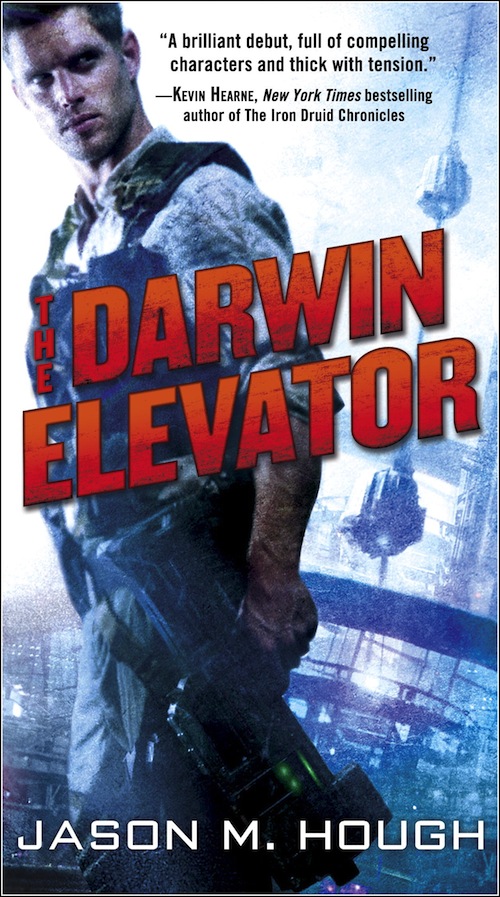To paraphrase Tropic Thunder, you never go full zombie. Not anymore at least. There are so many undead bodies in pop culture that a straight zombie tale of blood and terror needs another angle to shuffle its way out of the crowd. Jason M. Hough clearly understands this. In his debut novel, The Darwin Elevator, he’s constructed a story that is equal parts zombie thriller, alien mystery and corporate espionage extravaganza. It doesn’t quite live up to the sum of its parts, but everything moves along quickly and with enough bullets and explosions that it’s a helluva fun ride.
In the mid-twenty-third century, a plague has turned most of the world’s population into savage zombies (though they’re called subhumans here) and what remains of civilization is huddled ass-to-cheek in Darwin, Australia where a giant alien space elevator creates a safe haven against the disease. Nobody knows how or why the alien artifact protects people, only that it conveniently dropped from the sky soon before the outbreak and anyone who walks too far away from it for more than a few hours gets a severe case of red eye and then they want to eat their neighbor’s face. The relationship between the aliens, the space elevator and the subhuman plague are a tantalizing mystery that underpins the entire story. Just don’t expect any major revelations—this is the start of a trilogy after all.
Only a few people are immune to the disease, including the crew of the airship Melville. While everyone else has to put on protective suits to venture outside, captain Skyler Luiken and his team gallivant across the globe in their aircraft, picking through the ruins of civilization for valuable supplies. Of course, subhumans still roam the world and the crew get in some exciting scrapes where Skyler and his team have to shoot and sprint their way to safety. Hough doesn’t go full-GRRM, but he isn’t afraid to off both good and bad guys. Usually I applaud that kind of daring, but in this case it doesn’t mean much—only a few characters get more than a sketch of personality traits, and it’s difficult to get upset about the death of someone who you think might be the pilot but maybe he’s the mechanic or maybe the sniper.
Weak characters aside, the book’s strength is its relentless pace towards a confrontation that threatens to blow up basically everything. As the story unfolds, our scavengers are hired to recover data that could help a group of scientists crack the mystery surrounding the space elevator. And this mystery is more than an academic curiosity because there’s evidence that whatever protection the artifact offers against the subhuman disease is starting to break down.
Hough’s world building goes just deep enough to give a sense of how much it sucks to live in this future. Everyone is poor and hungry except for the few scientists and technicians who live on a space station docked above Darwin that is stocked with food, reliable technology and other luxuries. It’s a neat twist on the traditional conflict between haves and have-nots and sets the table for the climactic showdown between the scientists working to save humanity and the people stuck on the Earth’s surface who desperately want a more comfortable life.
The driving force behind the confrontation is the military commander of the surface forces, a man named Russell Blackfield. At first he seems like a dumb brute with a taste for power, but as the action escalates, he displays surprising cunning and a twisted sense of honor. He’s the most interesting character by far, even though Hough saddles him with a strange sexual perversion that makes him more like a creepy uncle than a disturbing psychopath. In comparison, Skyler is a decent but boring sort. His character arc is supposed to follow his growth into a leader, but most of the time he’s running around alone feeling guilty for his mistakes. Essentially he is a less charismatic Matthew Fox from the later seasons of Lost.
The other main character is Dr. Tania Sharma, one of the scientists leading the research efforts. Everyone says she’s brilliant, but her assistant frequently upstages her and far too many people outsmart her. Her biggest asset is her incredible hotness, which allows her to manipulate Russell on occasion. If Tania is going to keep on playing a major role in this series, I hope Hough lets her flex her brains some more because the way everyone tells her what to do all the time is depressing.
The marketing copy for Darwin Elevator promises a novel with the genes of a Firefly episode mixed with a John Scalzi novel. That’s pretty darn ambitious, and at least on this first entry Hough falls well short of conjuring the easy camaraderie that was the hallmark of the Serenity crew. He’s far more successful recreating the slick action sequences that I remember from Old Man’s War and other Scalzi novels. That, along with the intriguing alien mystery and the story’s rising stakes, is more than enough to bring me back for the sequel, which, amazingly, is due out in August. Perfect timing, because this sci-fi series is shaping up to be perfect summer reading material.
The Darwin Elevator is available now from Del Rey Books.
Matt Marquez is a freelance writer and photographer whose grade school teacher briefly thought he was a genius when he turned in his Shadowrun fan fiction for an assignment. Follow him on Tumblr and Twitter at @mattmarquez.










